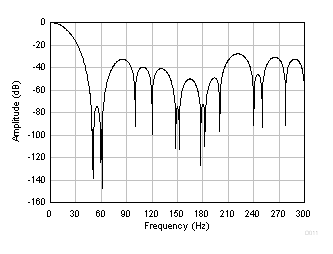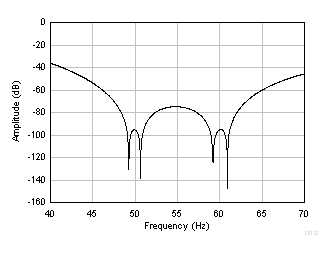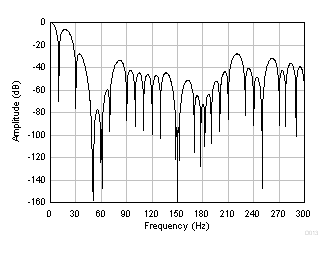SBAS661C February 2015 – May 2021 ADS1262 , ADS1263
PRODUCTION DATA
- 1 Features
- 2 Applications
- 3 Description
- 4 Revision History
- 5 Device Comparison
- 6 Pin Configuration and Functions
- 7 Specifications
-
8 Parameter Measurement Information
- 8.1 Offset Temperature Drift Measurement
- 8.2 Gain Temperature Drift Measurement
- 8.3 Common-Mode Rejection Ratio Measurement
- 8.4 Power-Supply Rejection Ratio Measurement
- 8.5 Crosstalk Measurement (ADS1263)
- 8.6 Reference-Voltage Temperature-Drift Measurement
- 8.7 Reference-Voltage Thermal-Hysteresis Measurement
- 8.8 Noise Performance
-
9 Detailed Description
- 9.1 Overview
- 9.2 Functional Block Diagram
- 9.3
Feature Description
- 9.3.1 Multifunction Analog Inputs
- 9.3.2 Analog Input Description
- 9.3.3 Sensor Bias
- 9.3.4 Temperature Sensor
- 9.3.5 Power-Supply Monitor
- 9.3.6 PGA
- 9.3.7 PGA Voltage Overrange Monitors
- 9.3.8 ADC Reference Voltage
- 9.3.9 ADC1 Modulator
- 9.3.10 Digital Filter
- 9.3.11 Sensor-Excitation Current Sources (IDAC1 and IDAC2)
- 9.3.12 Level-Shift Voltage
- 9.3.13 General-Purpose Input/Output (GPIO)
- 9.3.14 Test DAC (TDAC)
- 9.3.15 ADC2 (ADS1263)
- 9.4
Device Functional Modes
- 9.4.1 Conversion Control
- 9.4.2 Conversion Latency
- 9.4.3 Programmable Time Delay
- 9.4.4 Serial Interface
- 9.4.5 Data Ready Pin (DRDY)
- 9.4.6 Conversion Data Software Polling
- 9.4.7 Read Conversion Data
- 9.4.8 ADC Clock Modes
- 9.4.9
Calibration
- 9.4.9.1 Offset and Full-Scale Calibration
- 9.4.9.2 ADC1 Offset Self-Calibration (SFOCAL1)
- 9.4.9.3 ADC1 Offset System Calibration (SYOCAL1)
- 9.4.9.4 ADC2 Offset Self-Calibration ADC2 (SFOCAL2)
- 9.4.9.5 ADC2 Offset System Calibration ADC2 (SYOCAL2)
- 9.4.9.6 ADC1 Full-Scale System Calibration (SYGCAL1)
- 9.4.9.7 ADC2 Full-Scale System Calibration ADC2 (SYGCAL2)
- 9.4.9.8 Calibration Command Procedure
- 9.4.9.9 User Calibration Procedure
- 9.4.10 Reset
- 9.4.11 Power-Down Mode
- 9.4.12 Chop Mode
- 9.5 Programming
- 9.6
Register Maps
- 9.6.1 Device Identification Register (address = 00h) [reset = x]
- 9.6.2 Power Register (address = 01h) [reset = 11h]
- 9.6.3 Interface Register (address = 02h) [reset = 05h]
- 9.6.4 Mode0 Register (address = 03h) [reset = 00h]
- 9.6.5 Mode1 Register (address = 04h) [reset = 80h]
- 9.6.6 Mode2 Register (address = 05h) [reset = 04h]
- 9.6.7 Input Multiplexer Register (address = 06h) [reset = 01h]
- 9.6.8 Offset Calibration Registers (address = 07h, 08h, 09h) [reset = 00h, 00h, 00h]
- 9.6.9 Full-Scale Calibration Registers (address = 0Ah, 0Bh, 0Ch) [reset = 40h, 00h, 00h]
- 9.6.10 IDACMUX Register (address = 0Dh) [reset = BBh]
- 9.6.11 IDACMAG Register (address = 0Eh) [reset = 00h]
- 9.6.12 REFMUX Register (address = 0Fh) [reset = 00h]
- 9.6.13 TDACP Control Register (address = 10h) [reset = 00h]
- 9.6.14 TDACN Control Register (address = 11h) [reset = 00h]
- 9.6.15 GPIO Connection Register (address = 12h) [reset = 00h]
- 9.6.16 GPIO Direction Register (address = 13h) [reset = 00h]
- 9.6.17 GPIO Data Register (address = 14h) [reset = 00h]
- 9.6.18 ADC2 Configuration Register (address = 15h) [reset = 00h]
- 9.6.19 ADC2 Input Multiplexer Register (address = 16h) [reset = 01h]
- 9.6.20 ADC2 Offset Calibration Registers (address = 17h, 18h) [reset = 00h, 00h]
- 9.6.21 ADC2 Full-Scale Calibration Registers (address = 19h, 1Ah) [reset = 00h, 40h]
- 10Application and Implementation
- 11Power Supply Recommendations
- 12Layout
- 13Device and Documentation Support
Package Options
Mechanical Data (Package|Pins)
- PW|28
Thermal pad, mechanical data (Package|Pins)
- PW|28
Orderable Information
9.3.10.2 FIR Filter
The finite impulse response (FIR) filter of ADC1 is a coefficient-based filter that provides simultaneous rejection of 50-Hz and 60-Hz line cycle frequencies and harmonics. The FIR filter data rates are 2.5, 5, 10 and 20 SPS. All of the FIR data rates settle within a single conversion cycle. As shown in Figure 9-13, the FIR filter section receives data from the second-stage sinc filter at 600 Hz. The FIR filter section decimates by 30 to yield the output data rate of 20 SPS. A first-order averager (sinc1) with variable decimation provides the data rates of 10 SPS, 5 SPS, and 2.5 SPS.
As shown in Figure 9-22 and Figure 9-23, the FIR filter frequency response has a series of response nulls close to 50 Hz and 60 Hz. The response nulls repeat close to the 50-Hz and 60-Hz harmonics. The FIR frequency response superimposes with the response of the 600-SPS pre-stage filter.
 Figure 9-22 FIR Frequency Response (20 SPS)
Figure 9-22 FIR Frequency Response (20 SPS) Figure 9-23 FIR Frequency Response Detail
Figure 9-23 FIR Frequency Response Detail (20 SPS)
Figure 9-24 is the FIR filter response at 10 SPS. As a result of the sinc1 averager in the FIR filter block, new frequency-response nulls are superimposed to the response in Figure 9-22. The first of the added response nulls occur at 10 Hz. Additional nulls occur at folded frequencies around 20-Hz multiples. These additional nulls are seen at 10 Hz and 30 Hz.
 Figure 9-24 FIR Frequency Response (10 SPS)
Figure 9-24 FIR Frequency Response (10 SPS)Similar to the response of the sinc filter, the overall FIR filter frequency has a low-pass response that rolls off high frequencies of the signal. The response is such that the FIR filter limits the bandwidth of the input signal. The FIR filter signal bandwidth depends on the output data rate. Table 9-5 lists the –3-dB filter bandwidth of the FIR filter. The total system bandwidth is the combined individual responses of the digital filter, the ADC antialias filter, and external filter components.
| DATA RATE (SPS) | –3-dB BANDWIDTH (Hz) |
|---|---|
| 2.5 | 1.2 |
| 5 | 2.4 |
| 10 | 4.7 |
| 20 | 13 |